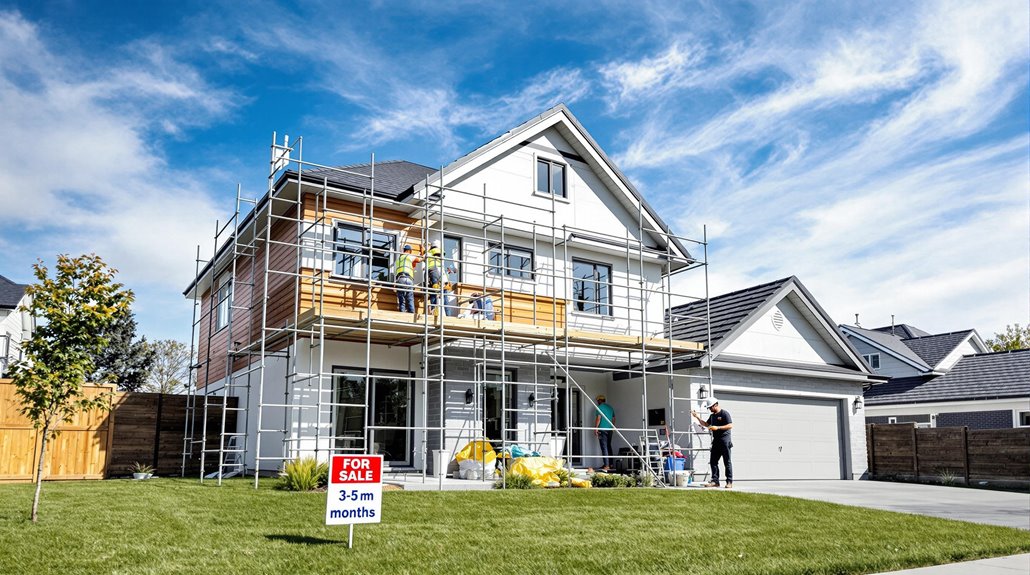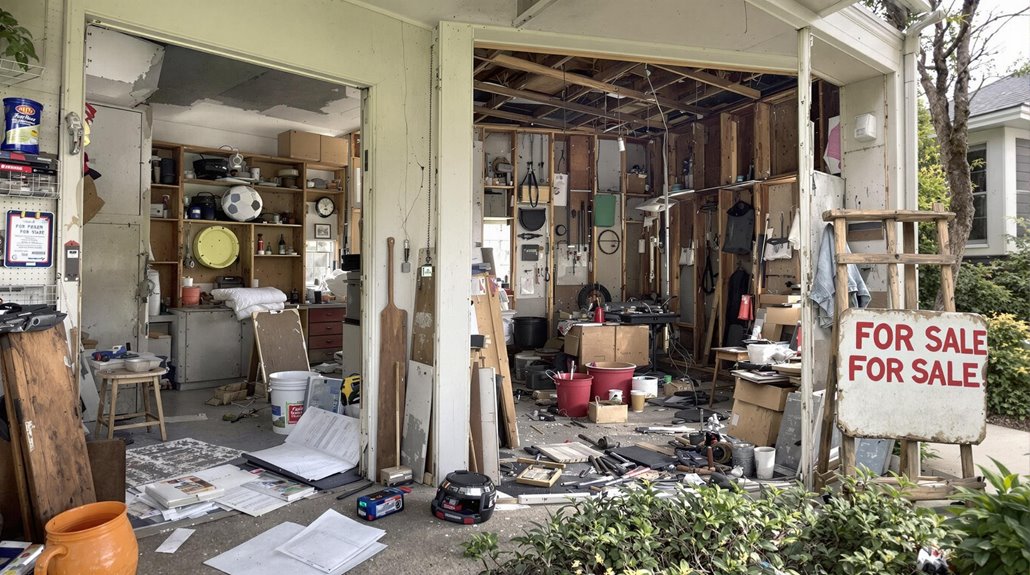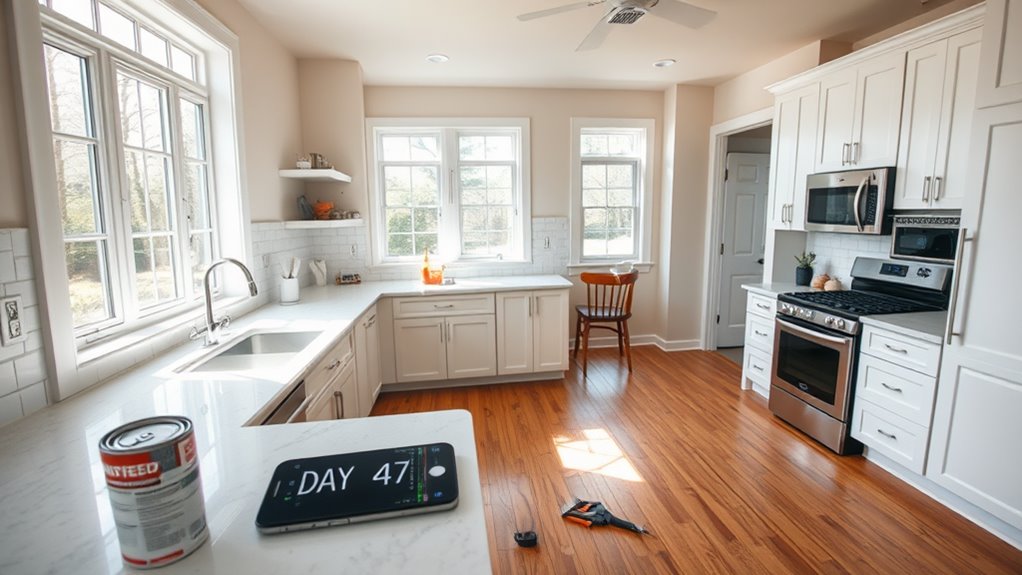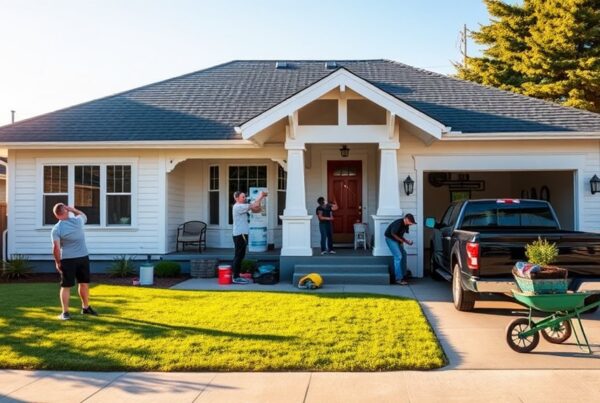On average, flipping a house takes 4 to 6 months, though this can vary based on factors like renovation scope, contractor availability, and market conditions. Proper planning helps manage holding costs and aligns the sale with favorable trends, but unexpected challenges like structural issues or permit delays can extend the timeline. Streamlining your approach and staying flexible are key to staying on track. Discover how to optimize your process and maximize profitability.
Key Takeaways
- The average time to flip a house is typically 4 to 6 months, including renovations and selling.
- Renovation duration usually takes 1 to 3 months, depending on the property’s condition and scope of work.
- Delays can occur due to contractor availability, permit approvals, or unexpected structural issues.
- Market conditions and buyer demand can extend the selling timeline by up to 2 months.
- Proper planning and a reliable contractor network help streamline the process to meet timelines effectively.
How Long Does It Take to Flip a House?
When flipping a house, timing isn’t just important—it’s critical. The average time to flip a house typically spans 4 to 6 months, covering purchase, renovation, and resale. Understanding how long to flip a house guarantees you’re prepared for holding costs, such as property taxes and utilities, which can erode profits if delays occur. Proper planning lets you synchronize renovations with market trends, guaranteeing a timely sale at peak market conditions. Knowing how long does it take to flip a house helps you set realistic expectations, avoiding rushed decisions that compromise quality or financial outcomes. Efficient time management also minimizes risks like unexpected repairs or fluctuating interest rates. By adhering to a well-structured timeline, you’ll maximize profitability and reduce stress, making your house-flipping venture more sustainable. Always remember, the clock starts ticking the moment you close the deal, so every day counts. Utilizing tools like the BRRRR Calculator can help assess property viability and ensure your flipping timeline aligns with financial goals.
Factors Influencing Flip Time
The condition of the property directly affects your flip timeline, as extensive repairs take longer than minor updates. Complex renovations, like structural changes or adding new features, can extend the project beyond the typical timeframe. Availability of contractors and materials also impacts speed, as delays in securing either will slow progress. Proper market analysis ensures you allocate sufficient time and resources for each phase of the flip.
Property Condition Impact
Property condition plays an essential role in determining how long it’ll take to flip a house, as renovations can range from minor updates to extensive overhauls. Homes in serious disrepair often require significant structural repairs, which can extend the timeline to six months or more. Conversely, properties needing only cosmetic fixes, like painting or flooring updates, might be completed in one to two months. Major renovations, such as adding bathrooms or altering layouts, add weeks due to their complexity. Unforeseen issues discovered during the process can further prolong the project. While the average renovation period ranges from one to three months, your timeline depends heavily on the property’s current state. During property selection, always assess the condition thoroughly to plan effectively and avoid delays.
Renovation Complexity Level
Because the complexity of renovations varies widely, it’s essential to understand how different factors influence flip time. Major changes like creating open-plan layouts or adding bathrooms often extend the timeline beyond the typical 1 to 3 months. Properties in serious disrepair usually require more extensive work, sometimes pushing projects over 6 months. Specialized skills or permit-heavy tasks introduce unforeseen delays, adding weeks or months. Landscaping and external improvements, while enhancing curb appeal, also add several weeks. You must anticipate these complexities when planning your flip to avoid underestimating the time required. Effective project management can mitigate some delays, but the nature of the renovation itself remains a significant determinant of your timeline. Always account for potential complications to set realistic expectations. A thorough financial forecasting plan can help accurately predict renovation costs and timelines, ensuring better project management and profitability.
Contractor Availability Speed
While planning your house flip, contractor availability can make or break your timeline, as delays in securing skilled labor often extend renovations beyond the expected 1 to 3 months. Seasonal demand peaks and local construction booms can limit access to reliable contractors, forcing you to wait longer or settle for less experienced help. Building relationships with dependable professionals and having backup options reduces the risk of delays, as trusted contractors may prioritize your project. Additionally, the scale and complexity of your renovations directly impact how quickly you can secure the necessary trades; specialized work often requires scheduling well in advance. Consider implementing cost-effective renovation strategies to ensure that your project stays on track and within budget. To minimize downtime, align your project timeline with contractors’ availability and plan for potential scheduling conflicts. Staying proactive guarantees smoother progress and helps you meet your flip deadline.
Average Time Required to Flip a House

The average time to flip a house hinges on your renovation timeframe and market conditions. Renovations typically take 1 to 3 months, depending on the project’s scope and contractor reliability, while market conditions may extend the search for buyers post-renovation by up to 2 months. Balancing these factors is key to managing your timeline effectively.
Renovation Timeframe
When flipping a house, you can expect the renovation timeframe to average between 1 to 3 months, though this heavily depends on the property’s condition and the scope of work required. Minor cosmetic upgrades like painting or updating fixtures will take considerably less time compared to major overhauls such as rewiring, plumbing, or structural repairs. Properties in serious disrepair often extend the renovation period due to unexpected issues uncovered during the process. To minimize delays, you’ll need to maintain clear communication with contractors and guarantee efficient project management. Always factor in potential setbacks when planning, as unforeseen complications can push timelines beyond initial estimates. Balancing speed with quality is critical, as rushed renovations can compromise the property’s market value. Leveraging data analysis can provide more accurate assessments of renovation timelines and costs, helping you make informed decisions. Effective planning and oversight are key to staying on track.
Market Conditions Impact
As market conditions shift, the average time required to flip a house—typically 4 to 6 months—can vary considerably. In a brisk market, properties may sell within a week of listing, while sluggish markets can extend selling times to several months or more. Local real estate trends and buyer demand impact each phase of the flipping process—finding, closing, renovating, and selling. Inventory levels and buyer competition also influence purchase speed; some investors secure properties in 5-10 days through wholesalers in competitive areas. Economic factors and seasonal trends further shape the timeline, with certain times of the year fostering faster sales. When demand is high, you’ll likely complete flips quicker, but challenging conditions can prolong the process. Understanding these variables helps you anticipate and plan for potential delays. Rental demand potential is a key factor in determining the speed and success of a house flip in a given market.
Detailed Time Breakdown by Stage
Flipping a house involves multiple stages, each with its own time commitment you’ll need to plan for. Finding a suitable property can take anywhere from a few days to several weeks, depending on market conditions and your criteria. Once you’ve identified a house, the closing process typically lasts 30 to 60 days, influenced by your mortgage broker and real estate lawyer’s efficiency. Renovations generally span 1 to 3 months, but this varies based on the project’s scope and contractor reliability. After completing upgrades, selling the property usually takes 1 to 2 months, though this depends on market conditions and pricing strategies. Overall, the entire process, from purchase to sale, averages 4 to 6 months when all stages align smoothly. House flipping also requires significant market knowledge and upfront capital, making it essential to research local trends and secure funding before starting.
- Property Search: Days to weeks.
- Renovation: 1 to 3 months.
- Selling: 1 to 2 months.
Challenges That Can Extend the Flipping Process

While the average flipping process spans 4 to 6 months, unexpected obstacles often disrupt this timeline. Extensive repairs and renovations can greatly extend your project, sometimes adding several months to completion. Delays in contractor availability are common, as scheduling conflicts can push back your timeline by weeks or even months. Unexpected costs, like discovering hidden structural issues, often lead to budget overruns, forcing you to reassess finances and prolong the process. Obtaining necessary permit approvals can also add substantial time to renovations, with delays sometimes stretching into weeks. Additionally, fluctuations in the local real estate market can influence your selling timeline. If the market is in a downturn or your property is priced incorrectly, you might face extended periods before closing a deal. These challenges, while manageable, require careful planning and flexibility to minimize their impact on your flipping timeline.
Tips for Streamlining the House Flipping Timeline
To streamline the house flipping timeline, it is essential to focus on strategic planning and efficient execution. Begin by developing a detailed renovation plan, as this can greatly reduce the renovation period, which typically lasts 1 to 3 months. Cultivate a reliable network of contractors and suppliers to guarantee timely access to labor and materials, minimizing delays caused by availability issues. Utilize efficient financing options like hard money loans, which can close in as little as 7 days, accelerating the purchasing process. Stay informed about local market conditions to align your selling strategy with demand, reducing the average selling time of 1 to 2 months post-listing. Regular communication with your renovation team helps proactively address potential issues, keeping the project on schedule and within budget.
- Plan thoroughly: Create a detailed renovation strategy.
- Build relationships: Rely on trusted contractors and suppliers.
- Stay informed: Monitor market trends for a faster sale.
Conclusion
When flipping a house, you’ll see that timing hinges on planning, execution, and unforeseen hurdles. How long does it truly take when variables like permits, contractor schedules, and market dynamics play a role? To streamline the process, prioritize clear timelines, reliable partners, and contingency plans. By meticulously managing each stage, you can minimize delays and maximize returns. Remember, mastering the art of efficiency can turn a prolonged project into a profitable venture.




